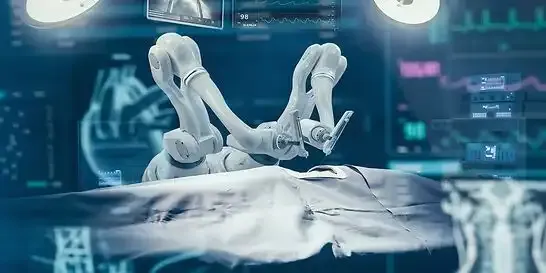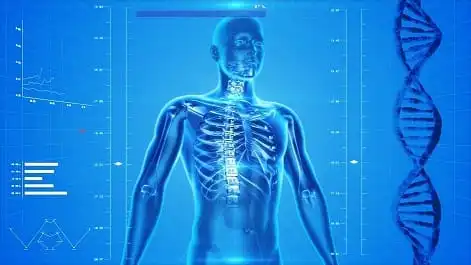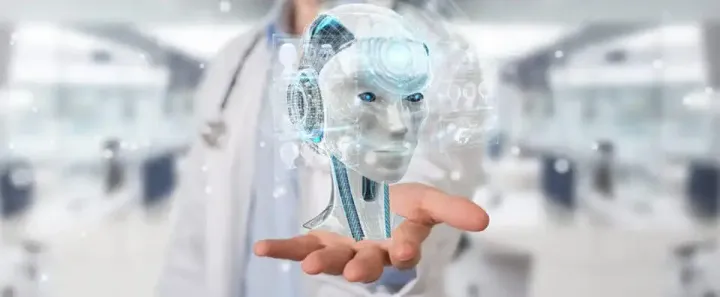Bionic Prosthetics: Advancing Limb Replacement with Tactile Sensing
Beyond movements, bionic prosthetics are now sensing. They are transforming the limb replacement by restoring tactile feedback. With the help of AI, bionic hand can now recognise texture and pressure, bringing sense back to hand. Learn how sensory repair can make these devices truly transformative.

Sense of touch is vital to the natural functionality of the human hand. It plays a major role in dexterity and interaction with the surrounding environment. Natural hands work through a continuous loop of motor commands and sensory feedback. This functionality helps individuals to perform highly skilled tasks. Meanwhile, the loss of a limb is a big challenge. It's not only physical but also emotional and physiological turmoil. This is where prosthetics have come a long way in restoring mobility. Prosthetic limbs offer means to fix some of the hand functions that are necessary for daily life. But one of the most indispensable elements has always been missing in prosthetic hands i.e. "sense of touch". Without this very sense, even the most innovative prosthetic hand feels just like a tool rather than any body part. But again technology is dominating. Sense of touch is possible with bionic prosthetics.
Recent innovations in the area of sensory feedback are making this dream into reality. Scientists and prosthetic manufacturers like Robobionics are continuously working on the sensations, pressure, and even texture of the prosthetic limb. That is why the need for prosthetic limbs is globally increasing. According to Allied Market Research, in 2021 the global prosthetic market was valued at $1.6 billion. Due to increased demand, market value is expected to reach $2.5 billion by 2031 at a CAGR of 4.5%. This innovative discovery is not just about making life more useful but also making the prosthetic limb truly useful for the belonging people. Therefore, the development of advanced bionic hands along with tactile feedback is designed to improve the quality of life among people with limb loss. So read the article till the end to know the innovative science behind bionic prosthetics.
Understanding the Current Limitations of Prosthetic Hands
Limited Sensory Capabilities
Current prosthetic hands have such sensory capabilities that are limited to basic pressure sensors for grip control. This kind of sensor cannot determine the improved details like texture, temperature, and other distinctions required for deeper manipulation. Therefore, many current prosthetic devices do not possess the same level of strength that a natural hand possesses. So, these devices are only capable of limited gestures which truly highlights the bigger gap in the design requirements.
Meanwhile, some state-of-the-art prosthetic hands integrate high-quality sensors. These sensors help in providing the valued information about the prosthesis and its surroundings. However this information is not effectively transmitted to the user like a natural sensation. Also, the provided feedback often seems to be undeveloped such as simple on/off signals, and also lacks the richness of natural touch.
Consequences of Lacking Tactile Feedback
The lack of natural tactile feedback in current prosthetic hands leads to some limitations. Users often over-rely on visual monitoring of the prosthetic limb during tasks. This over-reliance leads to a cognitive burden on the users which in turn reduces their ability to perform tasks instinctively. So, if the prosthesis does not induce a sense of embodiment then they are less likely to distinguish it as beneficial and incorporated.
Furthermore, the lack of tactile feedback makes the performance of the process difficult such as handling fragile objects. Without the sense of gripping the objects, users are prone to either drop the object or damage the one due to excessive force. This significant limitation restricts the range of the tasks that users can undertake.
The convergence of Prosthetics and Artificial Intelligence
Artificial intelligence is improving many industries and prosthetics is also one of them. It plays a vital role in the improvement of sensory feedback and overall user experience. The convergence of AI and bionic prosthetics is ready to create smarter and adaptive limbs that can counter the user's needs in actual time.
So, instead of just relying on manual adjustments, AI-powered prosthetics can learn from the user's conduct and polish their functionality with time.
The Role of AI in Enhancing Sensory Feedback
The biggest challenge in prosthetics is making the feedback natural. Artificial intelligence helps to solve this problem by processing heavy amounts of data from sensors that are implanted in the prosthetic limb. The sensors in the limbs help to detect the pressure, temperature texture, and movements. AI helps to translate these signals into eloquent sensations that the brain can understand.
For instance when an amputee holds a piece of fruit then AI immediately adjusts the pressure feedback to ensure that the user does not squeeze too hard. Moreover, if a prosthetic hand detects some slippery object then AI can automatically adjust the signals for grip strength to prevent the object from slipping. So these types of intelligent adjustments help the bionic hands to easily adapt to the system work. The more users interact with different objects the better AI will understand the level of grip and sensitivity of the objects for each task.
Recent Advancements in Restoring Touch
University of Pittsburgh's: Brain-Computer Interface
Recent advancements in the field of bionic prosthetics largely focus on the restoration of a sense of touch. University of Pittsburgh scientists have made massive progress in brain-computer interface (BCI) technology which enables individuals to feel the movement and shape of the “skin” of a bionic hand. This research demonstrates the ability to evoke strong tactile sensations for daily tasks by keeping the electrodes in the somatosensory cortex.
Furthermore, the coordinated patterns across multiple electrodes can help in creating the sensation of motion and edges which make the shift towards more adaptive and natural touch.
Johns Hopkins University's: Hybrid Prosthetic Hand
Another development made in bionic prosthetics is by John Hopkins University engineers. They have developed a revolutionary prosthetic hand that can combine both soft and rigid parts with touch-sensitive technology. It allows users to have precise and flexible object handling. This innovative hybrid robotic hand structures a multi-finger system. It contains rubberlike polymers and a rigid 3D-printed internal skeleton.
Along with that, the hybrid approach also contains three layers of tactile sensors that are inspired by human skin. So this entire design enables the hand to grasp and distinguish the objects of different textures and shapes. Additionally, the design also translates the sensory information into nerve like signals to provide a usual sensory feedback through electrical nerve stimulation.
Art behind Tactile/Sensory Feedback in Bionic Prosthetics
In bionic prosthetics, sensory feedback works by rewiring the missing connection between the brain and the limb. Here are some ways through which it can be attained;
Electrical Stimulus
In the amputated limb, electrodes are placed on the nerves. These electrodes helps in sending the tiny pluses which mimics the natural nerve signals. This trick helps the brain in perceiving the touch.
Vibration Sensors
Inside the prosthetic foot or hand, there reside small vibration motors. They help in creating a delicate bustling sensation when the limb touches something. This entire process helps the user to sense a contact or pressure.
Pressure Sensors
Pressure sensors in bionic prosthetics help to detect the amount of force that is being applied. After that, the sensors send the signals to the device which in return translates the signals in a way of feeling that brain can recognise.
Temperature Feedback
In terms of temperature, some of the researchers also discovered the use of thermoelectric devices which helps in identifying the temperature changes through prosthetic limbs.
Advanced Material Use in Bionic Hand Construction
Bionic hand construction prefers using material that can enhance dexterity and durability. The hybrid designs in which you can combine internal skeletons made of 3D printing with soft layers of polymers like silicon are proving to be the most effective ones in mimicking human hand structure and movements. This entire combination provides the strength for grasping the objects. Additionally, it also helps to handle objects of multiple shapes and textures without causing damage.
In terms of material use, rubber-like polymers are utilized for joints and outer surfaces to enhance the level of grip and of course tactile interaction. Furthermore, 3D printing technology is being continuously applied in bionic prosthetics to create customized hand structures. They are also used for rapid prototyping and plummeting industrial costs. So, this technology enables the formation of prosthetics with multifaceted geometries personalized to the user's anatomy and needs, thus refining the fit, comfort, and functionality.
Ongoing Research Initiatives Regarding Bionic Prosthetic Limbs
DARPA's Revolutionizing Prosthetics Program
Research initiatives are going stronger to make the bionic prosthetic process more natural. For instance, DARPA's revolutionizing prosthetic program is on its way to focus mainly on restoring both motor control and sensation in prosthetic limbs. One of the products of this program, known as "The Luke Arm” offers the dexterity and potential for sensory feedback through its advanced haptic sensors.
However, the current version mainly provides the grip force feedback through several vibrations. So, overall the program's emphasis on restoring sensory feedback suggests a trajectory towards more modern feedback shortly.
Advancements in Electronic Skin (E-Skin) Technology
Another leap forward in the Prosthetic bionic field is the advancements in electronic skin (e-skin) technology. Researchers have established e-skins that are capable of mimicking the structure and function of human skin. It includes the ability of both normal and shear forces with high spatial resolution.
For instance, in 2024 the three-dimensionally architected (3DAE-Skin) electronic skin was introduced. It comprises 3 layers that typically mimic the dermis, epidermis, and hypodermis along with the sensing components. This kind of array enables the decoupled sense of normal force with a spatial resolution comparable to the human hand. This innovative representation defines a clear step towards the provision of rich sensory information to the bionic hands.
Future Applications of Bionic Hands with Tactile Sensing
Bionic hands with the capability of advanced tactile sensing hold an enormous potential for future applications;
Daily Living
In daily living, the bionic prosthetic advancements can expand the ability of amputees to perform everyday tasks with comfort and confidence. Tactile feedback restoration enables the users to manipulate the objects without constantly looking. This enables multitasking and natural interactions.
For example, the bionic hand developed by Cleveland Clinic let the users to behave more like a person without an amputation due to the addition of motor control touch. Also, the hybrid robotic hand from John Hopkins clearly shows the ability to grip objects with accurate object surface detection. So we can say that the improved tactile feedback in modern prosthetics greatly helps to improve the quality of life for the users.
Surgery
In terms of surgery, bionic hands with improved tactile feedback have the great potential to revolutionise the robotic surgery. It can provide surgeons with improved realistic sense of touch when operating tissues. Furthermore, the integration of tactile feedback into robotic surgical tools can also help in enhancing the surgeon’s control, precision and the ability to differentiate between tissues.
Skilled Labor
For skilled labor, the bionic hands with sensory feedback can open up the opportunities in various industries that require fine motor skills. Right now, the lack of tactile feedback limits the use of prosthetics in highly skilled professions that greatly rely on a sense of touch. However, with innovative tactile capabilities, the amputees can work on assembly lines which requires the manipulation of small parts.
Additionally, they can also handle the tasks which require maintenance with the sense of touch to identify the material and textures. So we can say that the ongoing advancements promises to improve the quality of feedback for such applications.
Bionic Prosthetics: Final Thoughts
In conclusion, the bionic prosthetic field is undergoing rapid advancements. The restoration of tactile feedback is one of the breakthrough in this field which can truly transform the lives of all the amputees. Recent advancements in direct brain stimulation, hybrid designs, and electronic skin technology are making the way forward for more genuine/lifelike and functional limbs. While the challenges such as complexity, cost and long lasting neural interfaces will remain the continuous research efforts.
The long term collaborations between scientist, engineers, clinicians and significantly the users will be essential to realize the full potential of these innovative technologies. The widespread adoption will lead to greater independence and improved quality of life for individuals with lost limbs. With each moving step forward the bionic prosthetic journey is a promise to the amputees to feel the sense of touch once again.


